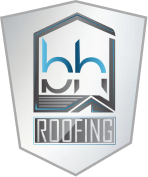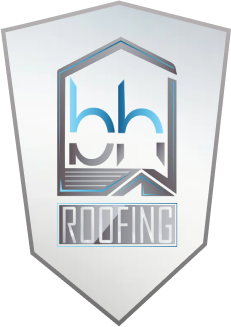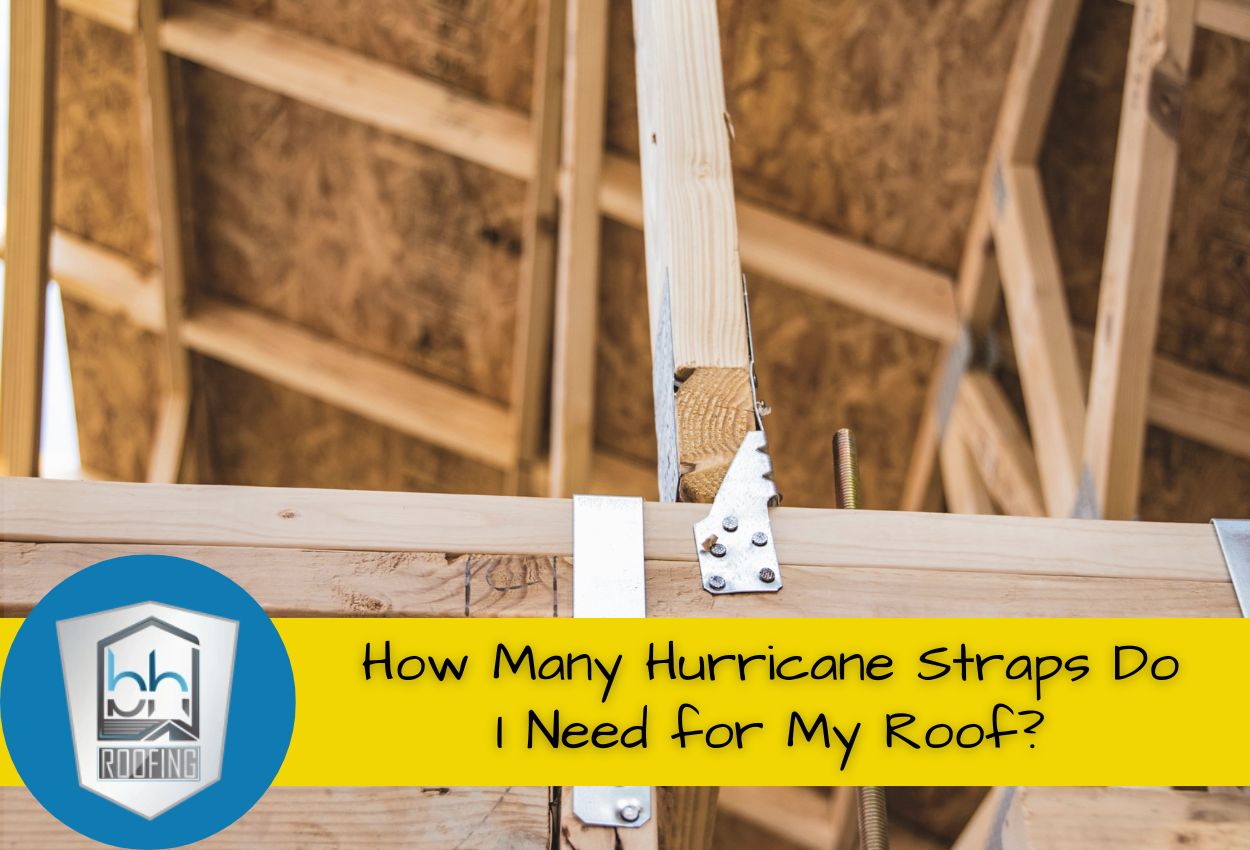Hurricane straps create critical connectors between your roof structure and the walls of your home, preventing catastrophic wind uplift damage during severe storms. These metal brackets, also called hurricane ties or clips, create a continuous load path that transfers wind forces from the roof down through the building’s frame to the foundation. Without hurricane straps, roofs can separate from homes entirely when subjected to high winds, resulting in devastating structural failure.
The number of hurricane straps required for adequate wind uplift protection depends on a few different factors, including roof size, truss spacing, local wind speed requirements, and specific building codes. Most residential structures require hurricane clips for roof trusses at every connection point where rafters or trusses meet the top plate of exterior walls.
Building codes for hurricane straps vary based on geographic location and local wind load requirements. Homes in high-wind zones often require additional reinforcement beyond basic hurricane straps. These variables help homeowners determine the exact quantity needed to achieve hurricane tie-down spacing that meets or exceeds local safety standards for maximum storm protection.
*Please note, this article is meant for general educational purposes only and is not intended to represent professional legal advice. Consult with a qualified attorney for advice regarding your specific situation.
Understanding Hurricane Strap Installation Requirements and Building Code Standards
Hurricane strap installation requirements are governed by strict building codes that vary based on regional wind conditions and structural specifications. The International Residential Code establishes baseline standards for wind uplift protection of residential roofing systems, requiring specific hurricane clips based on calculated wind loads. These codes determine minimum strap quantities, placement patterns, and fastener specifications that must be followed to ensure adequate structural integrity during severe weather events.
Local building departments typically require hurricane straps at every roof-to-wall connection point, with standard roof hurricane tie-down spacing following truss layouts. Most residential applications demand straps at 16-inch or 24-inch intervals, depending on local wind speed classifications and structural load requirements. Building codes for hurricane straps also specify the type and size of fasteners, minimum metal thickness, and proper installation angles to achieve maximum holding strength.
Building inspectors evaluate hurricane strap installations through visual inspections and framing stages. Compliance verification requires approved engineering plans, manufacturer specifications, and installation certificates that demonstrate adherence to local wind uplift protection standards. Inspectors check strap placement, fastener penetration depths, and connection integrity to ensure each installation meets the necessary requirements. Documentation must clearly show the total number of straps installed and their precise locations throughout the roof structure.
Spacing Guidelines for Roof Hurricane Ties
Standard roof hurricane tie-down spacing follows established patterns that ensure comprehensive wind uplift protection across the entire roof structure. Most residential applications require hurricane clips at 24-inch centers, though some high-wind areas mandate 16-inch spacing for enhanced security. The existing truss layout directly influences hurricane strap placement, as each connection point between rafters and wall plates requires individual reinforcement. Spacing calculations must account for the total roof area, truss configuration, and local wind load requirements to determine the exact number of hurricane straps needed.
Truss layout affects placement significantly, as irregular spacing or engineered lumber systems may require custom hurricane strap installation patterns. Standard 24-inch truss centers allow for straightforward strap placement, while 16-inch centers increase the total quantity needed but provide superior wind resistance. The roof pitch and span also influence spacing requirements, with steeper roofs and longer spans often requiring closer spacing to maintain adequate uplift resistance throughout the structure.
Different roof configurations need specialized spacing to achieve optimal wind uplift protection. Hip roofs generally require additional hurricane straps at corner intersections where multiple rafters converge, increasing the total quantity beyond standard calculations. Gable ends may need concentrated strap placement along rake walls where wind pressures concentrate during storms. Complex architectural designs with dormers, valleys, and irregular shapes require custom spacing to ensure every vulnerable connection receives sufficient reinforcement.
Selecting the Right Hurricane Clips and Connectors for Your Roof Trusses
Hurricane clips and connectors come in various configurations designed to match specific truss construction methods and lumber dimensions. Standard H1 clips work effectively with most conventional framing using 2-by-4 or 2-by-6 lumber, while H2.5A clips accommodate larger lumber and moderate loads. Twist straps provide flexibility for irregular connections, and rigid ties offer maximum holding strength for critical attachment points. The connector style must align perfectly with your existing truss system for proper load transfer and building code compliance.
Truss construction methods significantly influence connector selection, as manufactured trusses often require different hurricane clips compared to site-built rafters. Engineered lumber systems may need specialized connectors rated for specific materials like laminated veneer lumber or steel components. The lumber dimensions directly determine which connector sizes will provide adequate bearing surface and fastener penetration. Standard 2-inch nominal lumber requires different hurricane clips than 4-inch posts or engineered beams commonly found in contemporary construction.
Material specifications and load ratings determine which hurricane hardware will provide adequate holding strength for your specific roof. Galvanized steel connectors offer corrosion resistance and consistent performance in coastal environments, while stainless steel options provide enhanced durability in extreme conditions. Load ratings must meet or exceed calculated wind uplift forces based on roof hurricane tie-down spacing and local building codes.
Calculating Wind Uplift Protection Needs for Residential Roofing Systems
Wind speed zones and exposure categories directly determine the quantity and placement requirements for hurricane straps throughout your roof structure. Areas classified in higher wind zones require more frequent roof hurricane tie-down spacing and additional reinforcement at critical connection points. ASCE 7 Exposure Category B, C, and D reflect the surrounding terrain conditions, with Category D coastal areas having the highest hurricane strap installation requirements due to unobstructed wind flow. These classifications work together to establish minimum quantities needed for adequate wind uplift protection of residential roofing systems.
Engineering calculations for hurricane clips consider both sustained wind speeds and peak gusts when determining strap quantities. Wind zones with speeds exceeding 130 mph typically require hurricane straps at every truss connection, while lower zones may permit wider spacing intervals. The exposure category affects uplift pressure calculations significantly, as open terrain creates higher negative pressures that increase the total number of straps needed across the roof area.
Different sections of your roof experience varying uplift forces during storm conditions, requiring strategic placement of additional hurricane connectors in high-stress areas. Corner zones endure the most severe uplift pressures, often requiring multiple hurricane straps per connection point or specialized heavy-duty hardware. Edge areas along roof perimeters experience concentrated wind forces that need closer spacing between hurricane clips compared to central field zones. Understanding these pressure variations helps determine where building codes for hurricane straps require enhanced reinforcement beyond standard installation patterns.
Professional Installation vs. DIY Hurricane Strap Projects
Hurricane strap installation requires professional expertise when structural modifications, electrical work, or complex roof configurations are involved. Licensed contractors must handle projects requiring building permits, engineered lumber systems, or installations on homes with previous structural damage. Professional installation is also necessary when hurricane strap requirements exceed standard residential applications or when building codes mandate certified installer credentials. Structural engineers may need to evaluate unusual roof designs before determining appropriate hurricane clip placement.
Experienced DIY homeowners may be able to tackle basic hurricane strap projects on simple gable roofs with standard truss spacing and readily accessible connection points. These projects typically involve installing hurricane clips at clearly defined attachment locations using standard hardware and conventional lumber dimensions. DIY installations work best when existing tie-down spacing follows predictable patterns and when local building codes permit homeowner installation without professional oversight.
Tools needed for installation include pneumatic nailers, structural screws, measuring devices, and safety equipment, including fall protection harnesses and stable ladders. Common installation mistakes include using incorrect fastener lengths, inadequate nail depth, and improper strap alignment that compromises wind uplift protection. Missing or incorrectly spaced hurricane straps create weak points that can lead to catastrophic failure during severe weather, making precision and attention to detail critical regardless of who performs the installation work.
Maintaining and Inspecting Your Hurricane Strap System Over Time
Regular inspections help identify weaknesses within the roofing system before storm season arrives. Property owners should examine all visible hurricane clips and roof trusses annually, checking for loose fasteners, corrosion damage, or metal fatigue around connection points. Visual inspections should focus on areas where hurricane straps attach to both the truss members and wall plates, looking for gaps that indicate loosening or structural movement. Signs of rust, bent metal, or missing screws require immediate attention to maintain proper wind uplift protection for residential roofing systems.
Moisture infiltration is one of the most common causes of hurricane strap deterioration over time. Attic ventilation problems can cause condensation buildup that accelerates corrosion of metal connectors, weakening their holding capacity. Roof leaks directly expose hurricane hardware to water damage, particularly around penetrations and flashing areas where water can reach connection points. Regular attic inspections help identify moisture issues before they compromise the structural integrity of the entire roofing system.
Upgrading existing hurricane strap systems becomes necessary when building codes change or when roof modifications alter the original structural configuration. Adding dormers, skylights, or HVAC equipment affects wind load distribution and may require additional hurricane clips at new connection points. Aging hardware that shows signs of significant corrosion should be replaced with updated connectors that meet current standards. Homes built before modern hurricane strap installation requirements may need complete system upgrades to achieve adequate protection levels for today’s severe weather conditions.
Protect Your Home with BH Roofing’s Expert Hurricane Strap Installation
If you’re concerned about how many hurricane straps your roof needs to withstand the fierce winds in San Antonio, don’t guess and risk improper installation. Understanding the specifics of hurricane strap requirements can be complex, involving factors like roof size, truss spacing, and local building codes. BH Roofing specializes in not only determining the exact number of straps needed for maximum storm protection but also in professional installation that adheres to all building regulations.
Don’t wait for the next storm to test your roof’s resilience. Call BH Roofing today at (210) 267-9029 and ensure your home is prepared and protected. Our experienced team is ready to provide you with a comprehensive evaluation and high-quality installation of hurricane straps, customized to your roof’s specific needs and local San Antonio standards.


